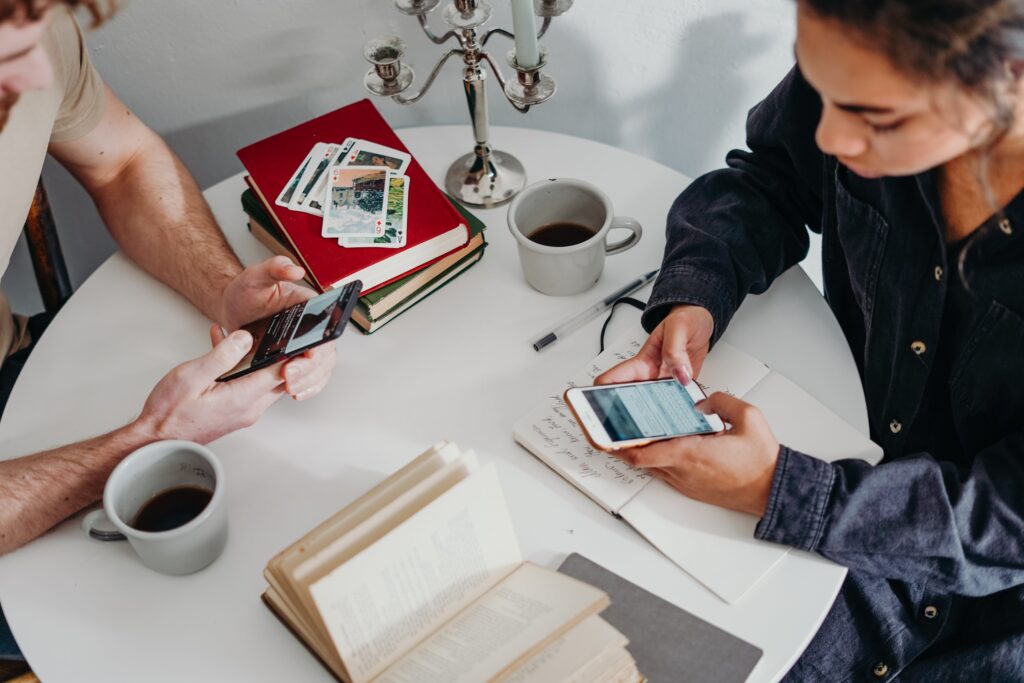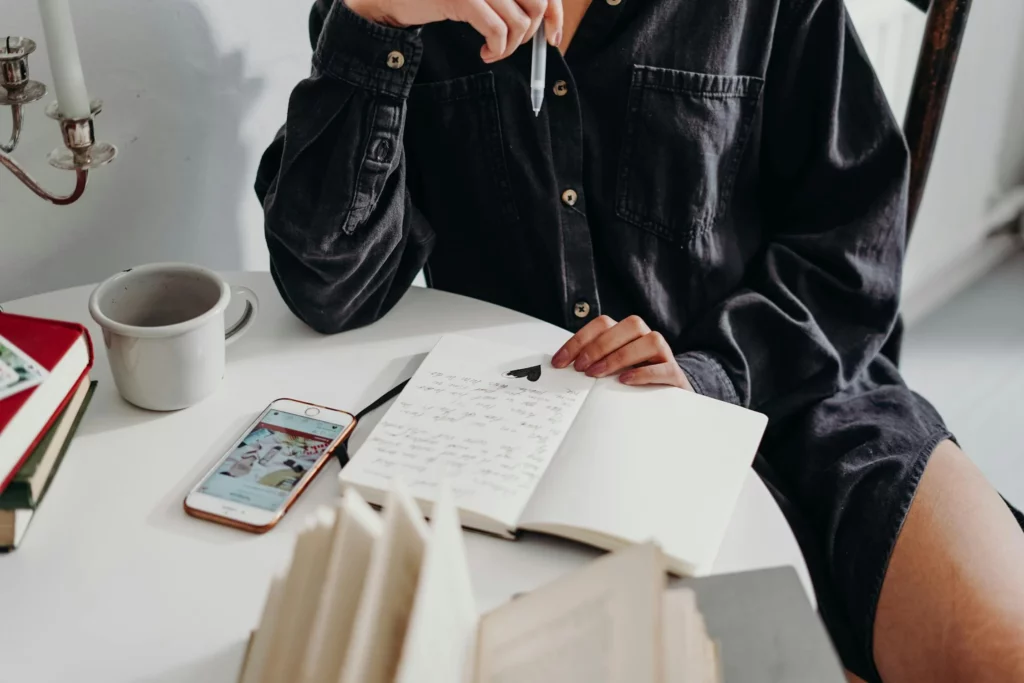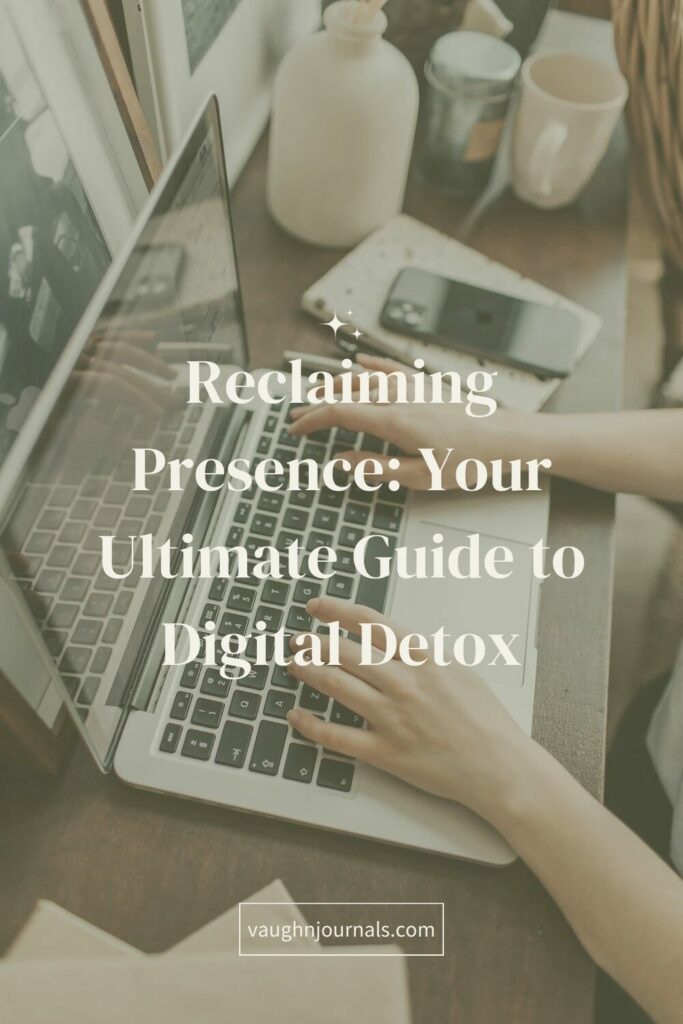
In the ever-connected digital landscape, the desire for balance rises, and for anyone who is just beginning their slow living journey, a guide to digital detox becomes a compass for intentional living. Welcome to “The Ultimate Guide to Digital Detox”, where I will guide you through everything you need to unplug, reset, and rediscover your life beyond the screens.
As you read through this guide, I’ll be explaining the why and how of detaching from the digital realm, exploring practical steps, mindful approaches, and the profound benefits awaiting you as you embrace intentional disconnection.
Whether you’re seeking breathing room from digital fatigue, aiming to prioritize mental well-being, or simply curious about unplugging, this guide to digital detox is a gateway to a more balanced, intentional, and fulfilling relationship with technology.
Let’s get started on this beginner-friendly exploration of digital detoxing, where simplicity, mindfulness, and the joy of being present await!
The Need for a Guide to Digital Detox
In our fast-paced digital era, the need for a digital detox has become so important.
Constant connectivity, notifications, and screen time all contribute to digital fatigue. This affects mental well-being and overall quality of life.
The incessant influx of information leads to information overload, diminishing focus and productivity. The addictive nature of social media fosters comparison and anxiety, which depletes genuine connections.
A digital detox is a crucial reset that offers a much needed break from the digital noise and allows us to reclaim our time and our attention. It cultivates mindfulness, enables a deeper connection with the present moment, and promotes mental clarity. Physically, excessive screen time can lead to digital eye strain and disrupted sleep patterns.
Embracing a digital detox is not simply a break from devices; it’s a conscious choice to restore balance, enhance well-being, and foster authentic human connections.
By unplugging, you can recalibrate your relationship with technology, prioritize your mental health, and embrace a more intentional and fulfilling lifestyle.

Understanding Digital Detox
What Is A Digital Detox?
A digital detox refers to a period during which a person refrains from using electronic devices and technology, such as smartphones, computers, and social media platforms.
The goal is to temporarily disconnect from the digital world, allowing us to reduce screen time, alleviate stress, and focus on real-world activities, relationships, and personal well-being. It’s a conscious effort to break free from the constant connectivity of the digital age and promote a healthier balance between online and offline life.
Benefits of a Digital Detox
A digital detox offers so many benefits for overall well-being. Here are just some of those benefits.
Improved Sleep Quality
Disconnecting from our devices supports better sleep by minimizing electronic stimulation. The light from our screens disrupts our circadian rhythms and can cause strain on our eyes which can make it harder for us to keep a good sleep schedule.
Enhanced In-Person Connections
When our only way of connecting with others is through face-to-face interactions, our relationships with others grow stronger as we have more meaningful interactions with them.
Mental Health Boost
Stepping away from constant notifications and information overload lowers stress levels. This can also help give a little boost to mental health and mindfulness as we are encouraged to be present in the moment and appreciate our surroundings.
One of the biggest downsides to social media is that we’re constantly comparing our day to day lives to the highlights of other people’s lives which can make us feel like we ourselves are not doing well in life.
Self-Reflection and Balance
Taking a break from our devices offers an opportunity for introspection and allows us to reassess our digital habits. Having a more intentional relationship with technology can help you live a more balanced life.
Assessing Your Digital Dependency
The very first step to doing a digital detox is to assess your dependency to technology. This involves reflecting on your digital habits and evaluating the impact of technology on your daily life.
Here are some steps to help assess your digital dependency:
- Screen Time Awareness
- Monitor the amount of time you spend on your digital devices. This includes smartphones, computers, and tablets.
- Reflection on Usage Patterns
- Reflect on when and why you use your digital devices. Are there specific triggers or situations that prompt excessive usage?
- Emotional Check In
- Assess your emotional responses to technology use. Do you feel anxious or stressed when separated from your devices?
- Physical Well-being
- Consider the physical impact of prolonged screen time on your health, such as eye strain, headaches, or disrupted sleep. Do you have any of these symptoms?
- Social Interactions
- Evaluate the quality of your in-person social interactions. Are digital devices interfering with your ability to connect with others?
- Productivity Levels
- Examine how digital devices affect your productivity. Are they helping or hindering your ability to accomplish tasks?
- Self-Reflection
- Engage in honest self-reflection about the role of technology in your life. What purpose does it serve, and is it aligned with your values?
- Digital Detox Experiment
- Try a short digital detox to observe your reactions and assess how dependent you may be on digital devices.
- Impact on Mental Health
- Consider the impact of digital use on your mental health. Are there signs of digital-related stress or burnout?
- Seeking Professional Guidance
- If you have concerns about digital dependency, consider seeking advice from mental health professionals or digital well-being experts.
Regularly assessing your digital dependency allows for a more mindful approach to technology use, promoting a healthier balance between the digital and real-world aspects of your life.

Planning Your Digital Detox
Planning a digital detox involves thoughtful consideration and intentional steps to reduce digital exposure. Here’s a guide to help you plan a successful digital detox:
Step 1: Set Clear Goals
Define the purpose of your digital detox. Whether it’s reducing screen time, improving focus, or enhancing well-being, having clear goals will help guide your detox.
Step 2: Choose a Duration
Decide on the duration of your digital detox. It could be a day, a weekend, a week, or any time frame that aligns with your goals.
Step 3: Communicate Your Intentions
Inform friends, family, and colleagues about your digital detox plan to manage expectations and avoid unnecessary communication during this period.
Step 4: Prepare Non-Digital Activities
Identify offline activities you enjoy, such as reading, hiking, drawing, or cooking. Be sure to have the necessary materials or resources ready.
Step 5: Set Boundaries
Establish clear boundaries for device usage. Consider turning off notifications, setting specific times for checking emails, and creating “no-tech” zones in your home.
Step 6: Plan Alternatives
Identify alternative ways to stay connected or entertained without digital devices. This can include board games, outdoor activities, or face-to-face conversations.
Step 7: Digital Declutter
Declutter your digital space before the detox. Delete unnecessary apps, organize files, and clear your inbox to reduce the digital load. You can even take it further by unfollowing social media accounts that don’t make you feel good or online “friends” that you haven’t seen or spoken to in years.
Step 8: Schedule Breaks
If a complete detox seems impossible, schedule short breaks throughout the day for digital use. You can still have a highly successful digital detox by swapping the constant connectivity for intentional and purposeful technology use.
Step 9: Reflect and Journal
Use a journal to document your feelings, experiences, and reflections during the detox. This can help you gain insights into your relationship with technology and help you pinpoint the obstacles you come across and find ways to overcome them. For a complete guide on how to journal, check out my blog post Journaling 101: A Guide for Beginners
Step 10: Evaluate and Adjust
At the end of the detox period, evaluate your experience. Identify what worked well, what challenges you faced, and how you can integrate healthier digital habits moving forward.
Remember, a digital detox is a personal journey, and customization is key. Tailor the plan to suit your lifestyle, and be open to adjusting it based on your observations and needs.

Overcoming Challenges
Overcoming challenges in a digital detox requires awareness, preparation, and commitment. Here are some strategies to address common obstacles:
Set Realistic Goals
Start with achievable goals. Gradually extend your digital detox duration as you become more comfortable. It can be really hard to quit “cold turkey” and so sometimes, just setting aside pockets of time to step away from digital devices is the best way to go.
Inform Others
Communicate your digital detox plans to friends, family, and colleagues to manage expectations and gain their support. You might find that making plans ahead of time is a lot easier for everyone involved and people will be a lot more likely to stick with those plans when they know that it’ll be that much harder to reach you otherwise.
Plan Alternative Activities
Prepare engaging non-digital activities in advance to fill the time you would typically spend online. In the next section, I will be going into further detail on some of the activities you can turn to when you’re itching for your phone.
Address FOMO (Fear of Missing Out)
Recognize and challenge the fear of missing out by focusing on the present moment and the benefits of the detox. You will soon learn that anything that is truly important for you to know will make its way to you, whether that be an invitation to an event or a recent trend.
Create Accountability
Share your digital detox goals with a friend or family member who can provide encouragement and hold you accountable.
Establish Tech-Free Zones
Designate specific areas, like the bedroom, where digital devices are not allowed to create dedicated spaces for unplugging. It can even be a specific corner of a room. So long as you have a space where you can take a break from all of the noise.
Use Technology Mindfully
If complete detachment feels challenging, practice mindful technology use by setting specific times for checking emails and messages. This tip works especially well when you turn the notifications off of certain apps on your phone and only open those apps during the blocks of time that you allot to these tasks.
Reflect on Triggers
Identify triggers that prompt excessive digital use. This could be specific emotions like when you feel sad or settings in your life such as when you’re on the toilet, when you first come home from work, or right when you wake up in the morning. Reflect on ways to address or redirect these triggers during the detox.
Stay Busy and Engaged
Keep yourself occupied with activities you enjoy, reducing the temptation to reach for digital devices out of boredom. Again, have a look at the next section for a list of analog activities.
Embrace Discomfort
Acknowledge that discomfort is a natural part of change. Embrace the opportunity to break habits and cultivate a healthier relationship with technology. You can be surprised with how much you can grow when you leave your comfort zone.
Prioritize Well-Being
Remind yourself of the well-being benefits associated with a digital detox, including improved focus, reduced stress, and enhanced mindfulness. It’s also important to note that a lot of change takes time and so it’s important not to rush your detox. This means that sometimes you need to focus more on finding balance between time spent on digital devices and time spent away from them.
Celebrate Small Wins
Acknowledge and celebrate the small victories during your digital detox. Recognizing progress can boost motivation.
Learn from Challenges
I know it can be really hard, but try viewing challenges as learning opportunities. Identify what aspects of the digital detox are difficult for you and strategize how to address them in the future.
Seek Support
If challenges persist, consider seeking support from friends, family, or professionals who can provide guidance and encouragement.
Remember, a digital detox is supposed to be a personal journey, and adapting strategies to fit your lifestyle is going to be the key to success. By addressing challenges with a proactive mindset, you can successfully navigate and derive meaningful benefits from your experience.
Embracing Analog Activities
Embracing analog activities, any little thing you can do that doesn’t require the use of modern technology, can bring about a sense of balance, mindfulness, and a break from the constant digital stimuli. Here are some analog activities to consider doing in place of screen time:
Read Physical Books
Rediscover the joy of holding a physical book, turning its pages, and immersing yourself in the story without the glow of a screen. You can also use an e-reader like a Kobo or a Kindle if you already have one. They’re designed to be gentle on the eyes with soft backlighting and they don’t send you notifications.
Write with Pen and Paper
Embrace the tactile experience of handwriting. Start a journal, jot down your thoughts, or engage in creative writing using pen and paper. This can also be a brilliant opportunity for self-reflection.
Get Creative With Art
Engage in analog art activities like drawing, painting, or crafting. The hands-on experience allows for self-expression and creativity. You might even have an old coloring book laying around that you can color in.
Try Board Games and Puzzles
You can gather your friends or family for analog entertainment through board games, puzzles, or card games that promote face-to-face interaction.
Explore The Great Outdoors
Spend some time outdoors without relying on digital devices. Take nature walks, go hiking, or simply enjoy the fresh air and natural surroundings. Bonus: If you have a dog, bring them with you for some added fun!

Cook or Bake Something
Dive into the world of culinary arts. Experiment with new recipes, cook meals from scratch, and savor the process of creating delicious dishes. You can also invite friends or family to join you in the tasting of the food you make.
Listen to Vinyl Records
Rediscover the rich sound of analog music by listening to vinyl records. This adds a nostalgic and immersive element to your musical experience.
Practice Photography with Cameras
Use a film camera for photography and experience the anticipation of waiting for film development and cherishing tangible photographs. Not a fan of the wait? Use an instant film camera. You can hang your favorite photos to your wall and scrapbook or journal the rest.
Engage in Physical Fitness
Engage in analog forms of exercise, such as yoga, weightlifting, or outdoor activities, without relying on digital fitness apps. Sometimes, just allowing your body to do what it feels like doing is the best form of exercise. You can do this by allowing your body to move itself through stretches in a yoga flow or by simply throwing on some music and dancing.
Learn Analog Skills
Pick up or practice skills like knitting, woodworking, or gardening, investing time in activities that require hands-on engagement. The bonus of this one is that you get a final product out of it which can feel incredibly gratifying.
Embracing analog activities provides a holistic and sensory experience, allowing you to disconnect from screens and find joy in the simplicity of the offline world. Integrating these activities can contribute to a more balanced and fulfilling lifestyle.

Tips for Reflecting on the Guide to Digital Detox Experience
Reflecting on a digital detox experience is crucial for understanding its impact and incorporating its lessons into your ongoing relationship with technology. Here are some tips on how to reflect effectively:
Journal Your Thoughts
Dedicate a journal entry to document your emotions, challenges, and discoveries during the digital detox. Explore how you felt at the beginning, during, and after. The more you write, the more information you’ll have to be able to go back in and look at your experience from a more objective perspective. This can help you identify your obstacles and help you find solutions.
Note Changes in Behavior
Identify any shifts in your behavior, such as increased focus, reduced stress, or changes in sleep patterns. Note positive changes as well as any areas where you might have struggled.
Evaluate Productivity
Assess your productivity levels during the detox. Consider whether you were more or less efficient in tasks, both digital and non-digital. This can help you determine how to move forward with your relationship with technology as you can keep what works and find tools and ways to cut out what doesn’t.
Examine Relationships
Reflect on how the detox affected your relationships. Did you notice improved communication with others? Did you experience any challenges in staying connected with anyone?
Explore Emotional Well-Being
Now delve into your emotional well-being. Did the detox contribute to a more positive mindset, reduced anxiety, or an improved sense of well-being?
Identify Triggers
Explore any triggers that prompted a desire to return to digital devices. Understanding these triggers can help you develop strategies for managing them in the future.
Celebrate Achievements
Celebrate the achievements and milestones you reached during the detox. It’s important to recognize the effort you put into unplugging and the positive outcomes that resulted from your hard work.
Consider Long-Term Changes
Contemplate which aspects of the digital detox you’d like to integrate into your regular routine. This might involve setting boundaries, creating tech-free zones, or scheduling regular breaks. Maybe it’s as simple as decluttering your social media or turning off the notifications on certain platforms.
Learn from Challenges
Identify the challenges you faced and try to determine the lessons you got from them. Whether it was dealing with boredom or facing the fear of missing out, use these insights for personal growth.
Share Experiences
Discuss your digital detox experience with friends or family members who may have also participated. Sharing insights can deepen your understanding and provide additional perspectives.
Plan Next Steps
Outline your next steps in maintaining a healthy relationship with technology. Consider whether periodic digital detoxes or ongoing mindful tech use align best with your goals.
Reflection serves as a powerful tool for personal growth and helps you make informed decisions about your digital habits. Use the insights gained through these prompts to shape a more intentional and balanced approach to technology in the future.
Integrating Digital Balance into Daily Life
Integrating digital balance into your daily life involves adopting mindful habits and setting boundaries with technology. Here are some practical first steps to achieve a healthier relationship with digital devices:
Create Tech-Free Zones
Designate specific areas in your home, such as the dining area or bedroom, where digital devices are not allowed. This can help to promote real-world interactions.
Establish Screen-Free Times
Set aside specific times during the day when you intentionally disconnect from screens. This could be during meals, before bedtime, or in the early morning.
Turn Off Notifications
Disable non-essential notifications on your devices to minimize distractions and interruptions, allowing you to focus on tasks without the constant alerts.
Mindful Social Media Use
Limit social media consumption by setting daily time limits or scheduling specific periods for social media use. Unfollow accounts that contribute to digital overwhelm or that generally don’t make you feel good.
Tech-Free Morning Routine
Begin your day without immediately reaching for digital devices. Instead, engage in activities like meditation, journaling, or enjoying a quiet breakfast.
Digital Sabbaticals
Plan periodic digital detox days or weekends where you intentionally disconnect from all digital devices to recharge and reset.
Prioritize Face-to-Face Interaction
Make a conscious effort to engage in face-to-face conversations and activities. Schedule regular meet-ups with friends and family to build meaningful connections. This can be a weekly game night or meal. It could even be as simple as meeting for a cup of coffee from time to time. I often do my groceries with family members outside my household. We have to get our groceries done anyways, may as well spend time with someone we love!
Mindful Multitasking
Be mindful of multitasking with digital devices. Instead, focus on one task at a time, enhancing efficiency and reducing digital clutter.
Tech-Free Hobbies
Cultivate hobbies that do not involve screens, such as reading physical books, gardening, or practicing a musical instrument.
Set Boundaries at Work
Establish clear boundaries between work and personal life by turning off work-related notifications outside of working hours. Create a dedicated workspace to minimize distractions. If you have to use a work phone, try keeping it separate from your personal one. I know this seems counterintuitive but believe me, in most cases, work should not have 24/7 access to you.
Digital Declutter
Regularly declutter your digital space by organizing files, deleting unnecessary apps, and unsubscribing from email lists and accounts that contribute to digital noise.
Be Mindful of Screen Time
Use built-in screen time tracking tools on devices to monitor your daily usage. Set realistic goals to gradually reduce your screen time.
Practice Mindfulness
Incorporate mindfulness practices into your routine, such as meditation or deep-breathing exercises, to stay present and centered amid the digital noise.

Reflect and Adjust
Regularly reflect on your digital habits and adjust your strategies based on your experiences. Be open to refining your approach to achieve a sustainable digital balance. You won’t find that perfect balance right from day 1, and that’s okay.
By adopting some of the practices in this guide to digital detox, you can create a healthier and more intentional relationship with technology, fostering a more balanced and fulfilling daily life.
Embarking on the journey this guide to digital detox can unveil a world beyond screens, where genuine connections and mindful moments can flourish. As beginners, we are discovering the transformative power of intentionally unplugging from digital devices, realizing that a break from technology is not just a pause but a deliberate choice for well-being.
This guide to digital detox is a starting point, emphasizing the importance of tech-free havens, intentional boundaries, and the joy found in analog pursuits.
Let’s carry these insights forward, shaping a future where technology enriches rather than overwhelms our lives. The beginner’s guide to digital detox marks the commencement of a mindful journey toward balance in our digital age.

Leave a Reply